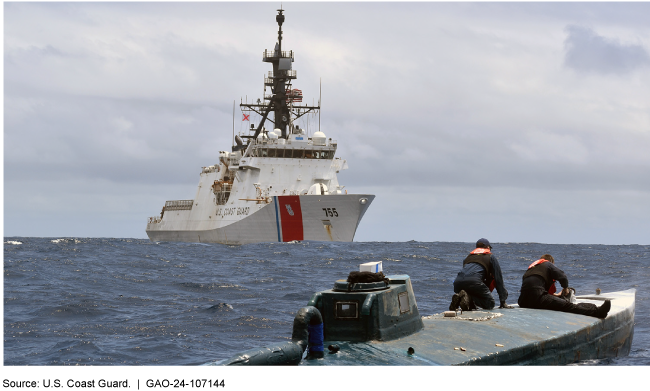Coast Guard: Actions Needed to Address Persistent Challenges Hindering Efforts to Counter Illicit Maritime Drug Smuggling
Fast Facts
This testimony discusses how federal agencies are combating the maritime flow of illicit drugs into the U.S.
These drugs—and the criminal organizations that traffic and smuggle them—are significant threats to national security and public health.
The Coast Guard leads operations to detect and disrupt the maritime flow of these drugs into the United States. It also provides ships and aircraft for such missions. But the Coast Guard has long faced challenges that affect these efforts. For example, personnel shortages and delays in replacing outdated ships have made it harder for the Coast Guard to meet mission goals.
A U.S. Coast Guard drug interdiction operation seized 17,000 pounds of cocaine.

Highlights
What GAO Found
Various federal agencies collaborate through task forces to detect and interdict the maritime flow of illicit drugs like cocaine and fentanyl. The task forces include members from Department of Defense and Department of Homeland Security (DHS) components, such as the Coast Guard. In 2019, GAO reported that the task forces generally coordinated effectively using mechanisms like working groups and liaison officers. However, task force agencies have not consistently assessed their efforts. GAO made 4 recommendations in this area.
Coast Guard Vessel and Aircraft Interdict Cocaine-laden Vessel Headed to U.S.

GAO has previously identified several challenges the Coast Guard faces that hinder its drug interdiction mission efforts. These include (1) asset readiness and availability, (2) acquisition challenges, and (3) workforce shortages.
- Coast Guard aircraft and vessels have not met availability targets. In 2023, GAO reported that Medium Endurance Cutters—a key asset for interdicting drugs—were not consistently meeting operational availability targets. The Coast Guard noted that the declining condition of the cutters risked decreased capability for meeting mission requirements.
- The Coast Guard faces persistent challenges managing acquisition program delays and affordability. For example, GAO found challenges with Coast Guard's acquisition of the Offshore Patrol Cutter that is intended to replace the Medium Endurance Cutter. This new cutter is essential for the service's drug interdiction mission, but acquisition delays are expected to create operational capability gaps through at least 2039.
- The Coast Guard reports having a shortage of about 10 percent of its enlisted workforce. However, as GAO found in 2020, the amount of the shortfall is unknown because the Coast Guard has not determined its service-wide workforce needs. As of November 2023, the Coast Guard reported that it completed workforce determinations for 15 percent of its workforce—as of September 2024, it had not implemented GAO's recommendation to develop a plan for doing so for the rest of its workforce. GAO has made 34 recommendations to address Coast Guard workforce issues; 28 have not yet been implemented.
Why GAO Did This Study
The U.S. government has identified illicit drugs, and criminal organizations that smuggle them, as significant threats. Many federal departments and agencies, particularly the Department of Defense and DHS, collaborate in efforts to reduce the availability of illicit drugs by countering their flow into the U.S. Given the federal government's challenges responding to the drug misuse crisis, GAO added national efforts to prevent, respond to, and recover from drug misuse to its High-Risk List.
This statement discusses (1) key federal coordination efforts to counter the maritime flow of illicit drugs and (2) challenges GAO has identified related to the Coast Guard carrying out its drug interdiction mission—and recommendations GAO has made to address these issues.
This statement is based on 36 prior GAO reports published from April 2010 through June 2024, along with selected updates on efforts to address previous GAO recommendations. For these reports, GAO reviewed agency documentation, analyzed data, and interviewed agency officials. For selected recommendation updates, GAO reviewed agency documentation and met with officials.
Recommendations
GAO made 105 recommendations in the reports covered by this statement. Agencies generally agreed with the recommendations. As of September 2024, 46 recommendations have been implemented. GAO continues to monitor the agencies' progress in implementing the remaining open recommendations.
